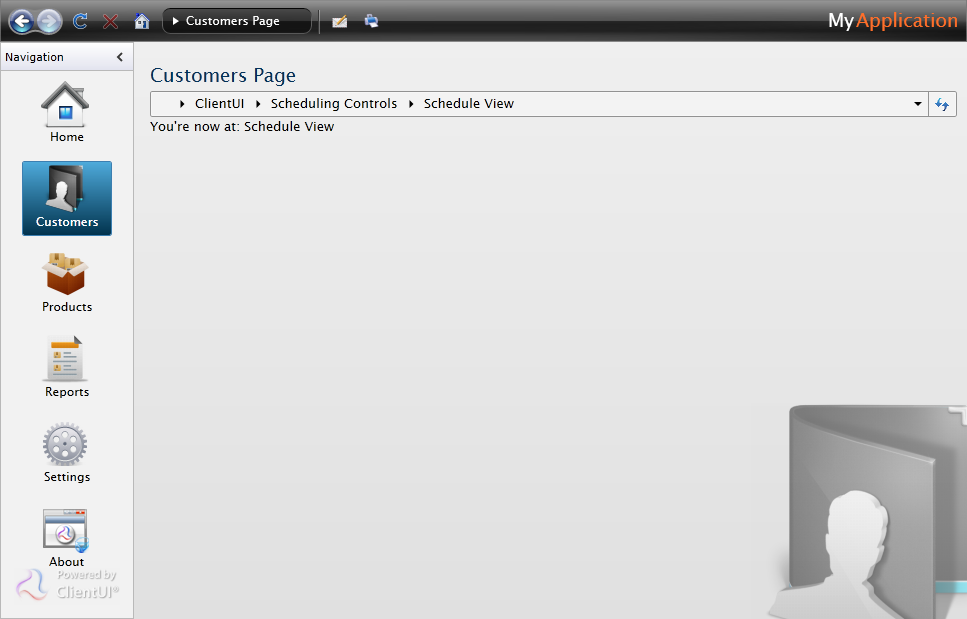

| Intersoft ClientUI 8 > ClientUI Controls > Control Library > Navigation Controls Overview > UXBreadCrumb > UXBreadCrumb How-to Topics > How-to: Use UXBreadCrumb for Page Navigation |
This example provides guidelines on how to use UXBreadCrumb in conjunction with UXFrame for page navigation.
For a quick example, we will use Intersoft ClientUI Data Application (DevForce) project. To create a new Intersoft ClientUI Data Application (DevForce) project, see Walkthrough: Create New Intersoft ClientUI MVVM Data Application (DevForce). We will modify the Customers page to include the UXBreadCrumb and a UXFrame and display a greeting text accordingly.
1. Create a new folder on the main project and name it XML.

2. Right-click on the folder, and select Add, New Item.
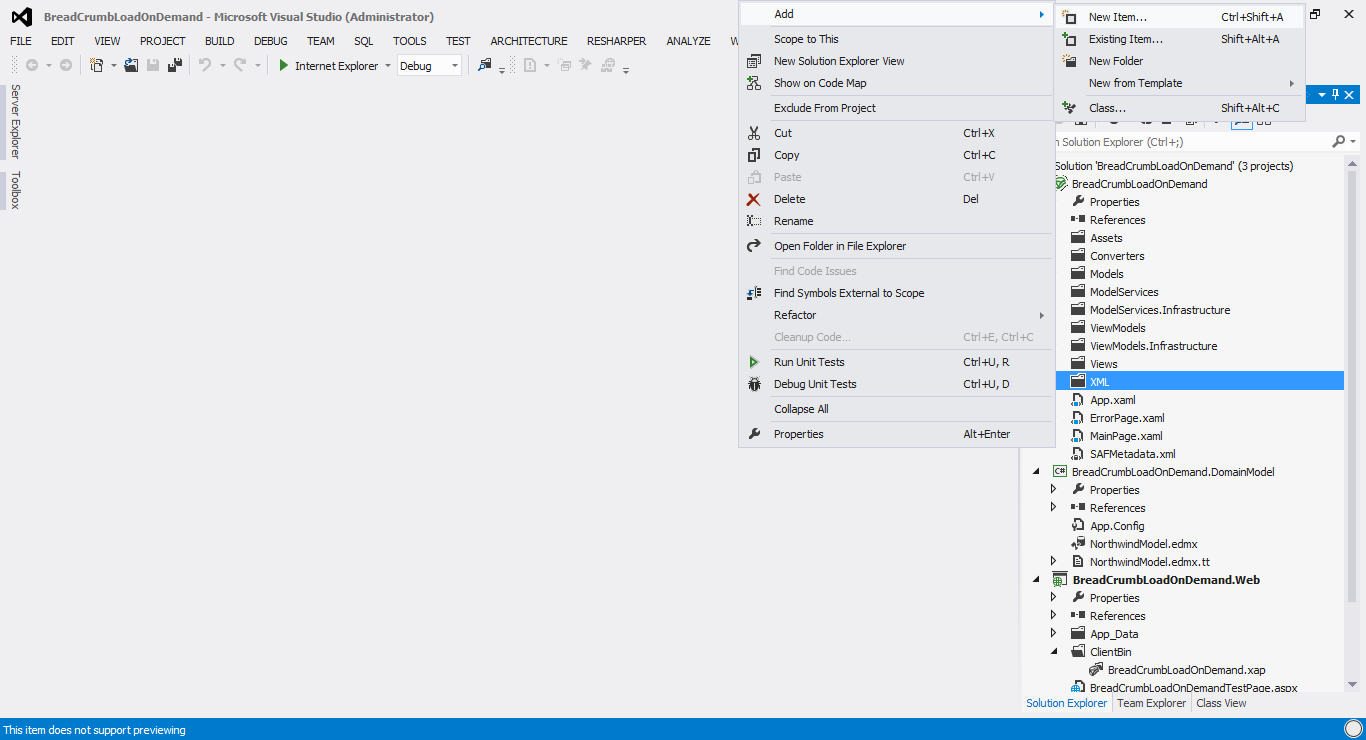
3. Select XML File, and name it Sitemap.xml.
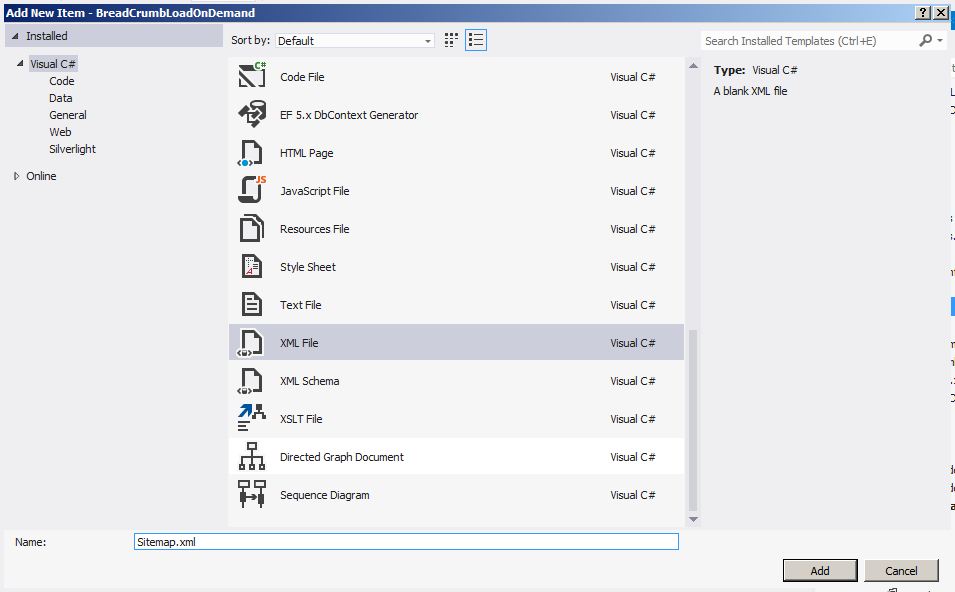
The sitemap content is as follows:
| Sitemap.xml |
Copy Code
|
|---|---|
<Sitemap> <SitemapData> <DisplayName>Home</DisplayName> <Path>/HelpViewer</Path> <Children> <SitemapData> <DisplayName>ClientUI</DisplayName> <Path>/HelpViewer/ClientUI</Path> <Children> <SitemapData> <DisplayName>Scheduling Controls</DisplayName> <Path>/HelpViewer/ClientUI/Scheduling Controls</Path> <Children> <SitemapData> <DisplayName>Schedule View</DisplayName> <Path>/HelpViewer/ClientUI/Scheduling Controls/Schedule View</Path> </SitemapData> </Children> </SitemapData> <SitemapData> <DisplayName>Ribbon Controls</DisplayName> <Path>/HelpViewer/ClientUI/Ribbon Controls</Path> <Children> <SitemapData> <DisplayName>Ribbon</DisplayName> <Path>/HelpViewer/ClientUI/Ribbon Controls/Ribbon</Path> </SitemapData> </Children> </SitemapData> </Children> </SitemapData> </Children> </SitemapData> </Sitemap> |
|
 |
You can also add icons to the sitemap by adding the appropriate nodes and specifying the ImageMemberPath property. |
4. Right-click on Sitemap.xml and choose Properties.
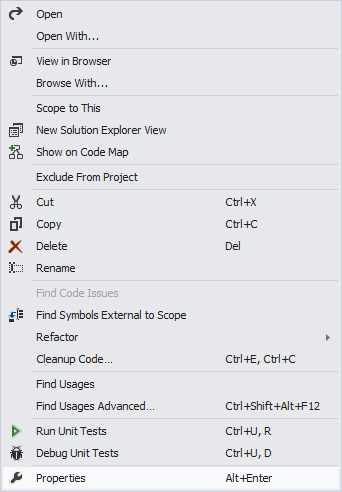
5. In the properties tab, set the Build Action of Sitemap.xml. This will allow resources to be parsed in the view model.
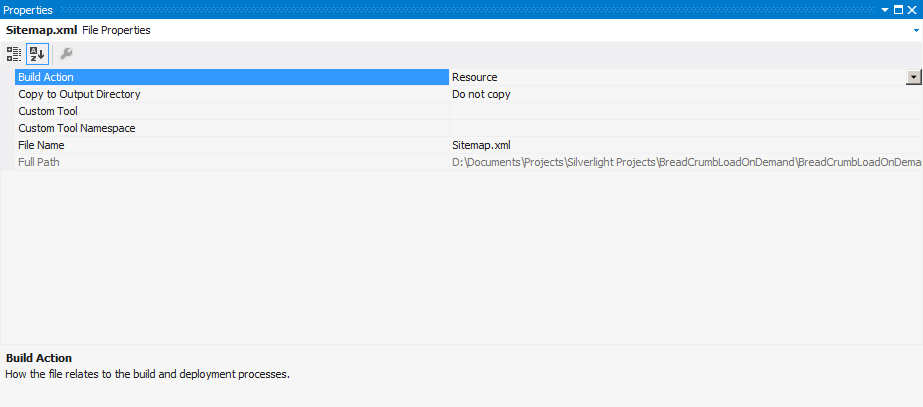
6. Create a new class named BreadCrumbViewModel.cs in the ViewModels folder. You can do this by right-clicking on the ViewModels folder, and select Add, Class.
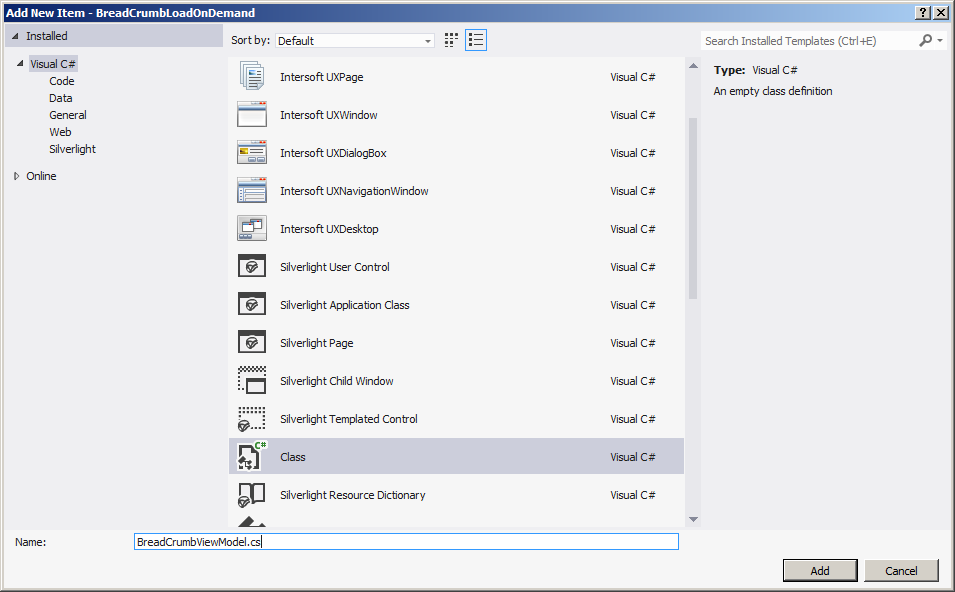
7. We will first create the skeleton ViewModel.
| BreadCrumbViewModel.cs |
Copy Code
|
|---|---|
using System; using System.Collections; using System.Collections.Generic; using System.Windows; using System.Windows.Input; using System.Windows.Resources; using System.Xml.Linq; using Intersoft.Client.Framework.Input; using Intersoft.Client.UI.Navigation; namespace BreadCrumbLoadOnDemand.ViewModels { public class BreadCrumbViewModel : ViewModelBase { private string _greetingText; private Uri _resolvedUri; public BreadCrumbViewModel() { //Get the StreamResourceInfo for the XML file StreamResourceInfo resourceStream = Application.GetResourceStream(new Uri("/BreadCrumbLoadOnDemand;Component/XML/Sitemap.xml", UriKind.Relative)); if (resourceStream != null) { XDocument xdoc = XDocument.Load(resourceStream.Stream, LoadOptions.SetBaseUri); //Use the utility method to generate sitemap from XML Sitemap = Intersoft.Client.UI.Navigation.UXBreadCrumb.GenerateSitemap(xdoc, "DisplayName", "Path", "Children", null); } //Use ICommand to track navigate event and display greeting text accordingly this.NavigateCommand = new DelegateCommand(Navigated); } private void Navigated(object obj) { NavigatedCommandParameter parameter = obj as NavigatedCommandParameter; if (parameter != null) { //OnPropertyChanged will be called this.ResolvedUri = parameter.Uri; } } public ICommand NavigateCommand { get; set; } public IEnumerable<SitemapData> Sitemap { get; set; } public string GreetingText { get { return this._greetingText; } set { if (this._greetingText != value) { this._greetingText = value; OnPropertyChanged("GreetingText"); } } } public Uri ResolvedUri { get { return this._resolvedUri; } set { if (this._resolvedUri != value) { this._resolvedUri = value; OnPropertyChanged("ResolvedUri"); //After ResolvedUri has been set, find the appropriate display name to be displayed to GreetingText this.FindDisplayNameRecursive(this.Sitemap); } } } private void FindDisplayNameRecursive(IEnumerable sitemap) { if (sitemap != null) { foreach (SitemapData sitemapData in sitemap) { if (sitemapData.NavigateUri == this.ResolvedUri) { this.GreetingText = "You're now at: " + sitemapData.DisplayName; break; } if (sitemapData.Children != null) this.FindDisplayNameRecursive(sitemapData.Children); } } } } } |
|
8. Open Customers.xaml in folder Views, and modify to the following code:
| Customers.xaml |
Copy Code
|
|---|---|
<Intersoft:UXPage xmlns="http://schemas.microsoft.com/winfx/2006/xaml/presentation" xmlns:x="http://schemas.microsoft.com/winfx/2006/xaml" xmlns:d="http://schemas.microsoft.com/expression/blend/2008" xmlns:mc="http://schemas.openxmlformats.org/markup-compatibility/2006" mc:Ignorable="d" xmlns:Intersoft="http://intersoft.clientui.com/schemas" xmlns:ViewModels="clr-namespace:BreadCrumbLoadOnDemand.ViewModels" x:Class="BreadCrumbLoadOnDemand.Customers" Title="Customers Page" d:DesignWidth="800" d:DesignHeight="600" Style="{StaticResource CommonPageStyle}"> <Intersoft:UXPage.DataContext> <ViewModels:BreadCrumbViewModel /> </Intersoft:UXPage.DataContext> <Grid x:Name="LayoutRoot"> <Grid.Background> <ImageBrush AlignmentY="Bottom" AlignmentX="Right" Stretch="None" Opacity="0.5" ImageSource="../Assets/Images/CustomersFolderLarge.png"> <ImageBrush.Transform> <TranslateTransform X="40" Y="40" /> </ImageBrush.Transform> </ImageBrush> </Grid.Background> <Intersoft:DockPanel Margin="10" FillChildMode="Custom"> <Intersoft:StylishLabel Content="Customers Page" Intersoft:DockPanel.Dock="Top" Style="{StaticResource PageHeaderStyle}" /> <StackPanel Intersoft:DockPanel.IsFillElement="True"> <Intersoft:UXBreadCrumb Sitemap="{Binding Sitemap}" DisplayMemberPath="DisplayName" NavigateUriMemberPath="NavigateUri" CollectionMemberPath="Children" TargetFrame="MainContentFrame" /> <Intersoft:UXFrame x:Name="MainContentFrame" JournalOwnership="OwnsJournal" Source="/HelpViewer/ClientUI/Scheduling Controls/Schedule View"> <Intersoft:UXFrame.UriMapper> <Intersoft:UriMapper> <Intersoft:UriMapping Uri="/HelpViewer" MappedUri="/Views/TestPage.xaml" /> <Intersoft:UriMapping Uri="/HelpViewer/{page}" MappedUri="/Views/TestPage.xaml?uri={page}" /> </Intersoft:UriMapper> </Intersoft:UXFrame.UriMapper> </Intersoft:UXFrame> </StackPanel> </Intersoft:DockPanel> </Grid> </Intersoft:UXPage> |
|
For more information on UXFrame, see UXFrame page.
9. Create a new UXPage for a test page, named TestPage.xaml in the Views folder. This is the target frame page.

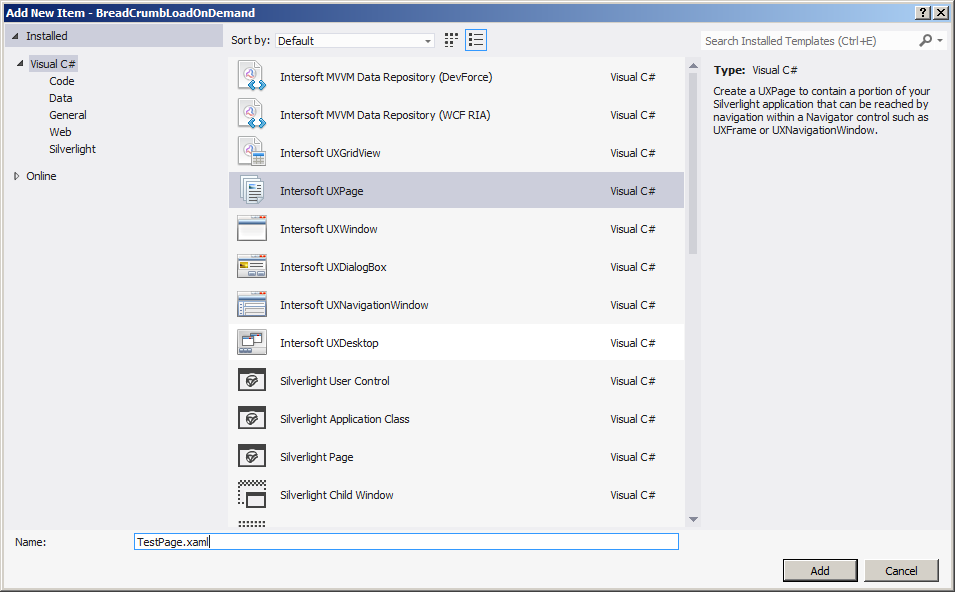
| TestPage.xaml |
Copy Code
|
|---|---|
<Intersoft:UXPage xmlns="http://schemas.microsoft.com/winfx/2006/xaml/presentation" xmlns:x="http://schemas.microsoft.com/winfx/2006/xaml" xmlns:d="http://schemas.microsoft.com/expression/blend/2008" xmlns:mc="http://schemas.openxmlformats.org/markup-compatibility/2006" mc:Ignorable="d" xmlns:Intersoft="http://intersoft.clientui.com/schemas" xmlns:ViewModels="clr-namespace:BreadCrumbLoadOnDemand.ViewModels" x:Class="BreadCrumbLoadOnDemand.Views.TestPage" Title="TestPage Page" d:DesignWidth="640" d:DesignHeight="480" NavigatedCommand="{Binding NavigateCommand}"> <Intersoft:UXPage.DataContext> <ViewModels:BreadCrumbViewModel/> </Intersoft:UXPage.DataContext> <Grid x:Name="LayoutRoot"> <TextBlock Text="{Binding GreetingText, Mode=TwoWay}" /> </Grid> </Intersoft:UXPage> |
|
10. Run the project and navigate to Customers page.
